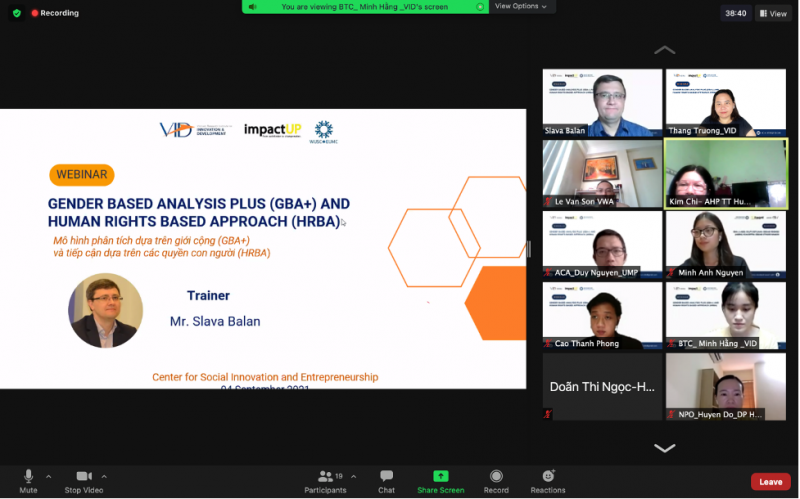Gender-Based Analysis (Gender+) and Human Rights-Based Analysis
September 7, 2021
Gender-Based Analysis Plus Approach (GBA+) & Human Rights
-Based Approach (HRBA)

| On September 4, 2021, the Institute for Innovation and Development Studies invited Mr. Slava (Veaceslav) Balan, PhD student at, the University of Ottawa Law School to present the topic of Gender-Based Analysis Methods (Gender +) and Human Rights-Based Analytical Methods. |
Gender-based analytics plus (GBA+) is the analysis of specific data, actions, or habits in a discrete manner (by some reason/groups in addition to gender (gender +) – age, race, people with disabilities, etc. – to identify actual or potential impacts on groups of women and men (negative, positive or neutral).
According to Mr. Slava, all humans have multiple identities and intersecting characteristics, including gender, age, disability or not, family status, mother tongue, cultural background, beliefs, nervous system, etc. All these identities and characteristics intersect and create complex human personalities. When doing gender-based analysis+ (GBA+), we should make clear distinctions between multiple people and between groups, e.g.
- Not all women are disadvantaged and discriminated against equally – some women are disadvantaged and discriminated against more.
- Women with disabilities often suffer more disadvantages and discrimination than normal women or men with disabilities. Therefore, women with disabilities face many disadvantages and discrimination, and GBA+ focuses on addressing this issue.
What is GBA+? The Canadian Department of Justice provides the following definition of GBA+ approaches:
- GBA+ is an analytical tool used to evaluate the potential impacts of policies, programs, services, and other initiatives on groups of women, men, and people of different gender identities. different.
- The plus sign here is to emphasize that this analytical approach is not solely based on gender but includes consideration of intersecting identity factors, including age, sexual orientation, disability, education, language, geography, culture, and income
Guiding principles for implementing GBA+
The Canadian Department of Justice breaks down the definition of GBA+ by providing a few guiding principles:
- Integrated and systematic approach: GBA+ should be implemented regularly throughout key stages of new initiative development, from planning to evaluation, with analysis of key opinions. other important.
- Evidence-based: GBA+ should be evidence-based, relying on reliable statistics, data, and research. When presenting options, GBA+ should be considered as a factor in future options.
- Realizing reform of social norms: Comprehensive GBA+ analysis requires challenging assumptions that can influence policy. It’s important to realize that social norms are constantly evolving and we need to always question assumptions. Wrong assumptions can lead to unintended impacts on diverse groups of people
Main concepts and elements of GBA+
The Canadian Department of Women and Gender Equality breaks down the key concepts and elements of GBA+ even further in their online training course:
- GBA+ can be applied anywhere – across all organizational and policy, program and environmental activities, including research, policy development, program design, service delivery and operations, legal services, communications, evaluation and monitoring;
- Applying GBA+ to policy development is important, as women, men and non-binary people may experience the same issues differently, or be affected differently by policy. Therefore, problem analysis and solution proposals will need to be based on these differences.
- GBA+ requires that the following questions be asked: Have stakeholders been consulted? Do they represent a diversity of perspectives? Have affected communities been consulted?
Practical Steps (Gender Analysis)
1. Gather gender-disaggregated data (broken down by women and men) Gather gender-disaggregated data (broken down by women and men)
2. Analyze the data to identify gender gaps (gaps between women and men) Analyze the data to identify gender gaps (gaps between women and men)
3. Qualitative data and analysis – Why do we have the gaps? (What are the barriers?) Qualitative data and analysis – Why is there a gap? (What are the barriers?)
4. Planning and implementing measures to remove the specific barriers (micro-level) – jointly with the affected group)
5. Planning and implementing structural/systemic reforms (macro-level) – again, jointly with the affected group
Practical Steps (GBA+)
1. Gather gender+ disaggregated data (gender+age, gender+disability, gender+rural/urban, etc) Collect gender+ disaggregated data (gender+ age, gender+ disability, gender+ rural/urban, etc) ;
2. Analyze the data to identify gender+ gaps (gaps between aged women vs aged men and non-aged women, etc) Analyze the data to identify gender+ gaps (gaps between aged women vs aged men and non-aged women, etc) and young women);
3. Qualitative data and analysis – Why do we have the gaps? (What are the barriers?) Qualitative data and analysis – Why is there a gap? (What are the barriers?);
4. Planning and implementing measures to remove the specific barriers (micro-level) – jointly with the affected group(s) affected group;
5. Planning and implementing structural/systemic reforms (macro-level) – again, jointly with the affected group(s) enjoy.
Next, Mr. Slava presented the human rights-based approach (HRBA).
HRBA is a more complex approach than GBA+. “Human rights-based approach” is a term commonly used by United Nations agencies for more than 20 years, closely related to the concept of “human development”. development ). First, HRBA is one of the fundamental principles of the 2030 Sustainable Development Program in building and implementing development programs/projects. However, it is now being expanded to general public policy planning and implementation in countries.
The HRBA is based on widely accepted international human rights standards. The HRBA establishes certain minimum rights for all people. These rights ensure a good life and self-realization in life (in many forms). Organizations, especially state agencies, have an obligation to enforce these basic human rights. The main function of institutions is to recognize human rights (collective and individual). Progress is measured in people and the extent to which they enjoy their rights. Focus primarily on vulnerable groups (GBA+) – “No one left behind!”
Finally, HRBA emphasizes transparency, participation, responsibility, and empowerment. That means HRBA not only cares about achieving the set goals but also focuses on the processes and procedures implemented to achieve those goals. HRBA is a reasonable and correct approach both legally and ethically and mustcountries apply HRBA for that reason.
Doan Thi Ngoc















